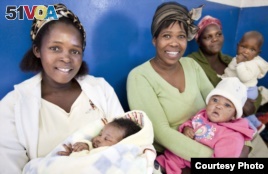April 22,2013
In recent years, in developing countries, adults infected with HIV have had greater access to treatment. But UNAIDS says children still lag behind in accessing antiretroviral drugs, especially those formulated just for children. It warns that most who go untreated will die by their fifth birthday.

Mothers in Swaziland are among those benefiting from EGPAF programs. (Credit: EGPAF)
The Elizabeth Glaser Pediatric AIDS Foundation says progress is being made in preventing new infections in children. It says there’s been a 24 percent reduction in new infections since 2009. Much of that is due to providing antiretrovirals to more HIV positive pregnant women.
Nevertheless, there’s much more to be done.
“We still have way too many children being infected and just in sub-Saharan Africa last year there were 300,000 kids with new infections. That’s way too many. So, we have the new infections and we’re having problems in identifying those kids and getting them on treatment early enough,” said Mary Pat Kiefer, the foundation’s senior director for technical leadership.
It’s estimated that globally only 28 percent of children needing HIV treatment received it in 2011. Kiefer says part of the problem lies in many African health care systems, which are not able to link children of HIV positive women to the right services.
“I would say overall that we’re able to identify maybe 50 percent of those HIV exposed kids and test them. Very often the mothers will bring their kids for services at a different place than where the mother received her services during pregnancy. And we still then have problems with the quality of services in some of the facilities and making sure we have everything in a place and can provide the services to the kids,” she said.
Treating a child with HIV is not simply a matter of providing a lower dose of adult medication. It must be specially formulated for a child’s body.
Kiefer said, “The situation with pediatric drugs is better, but we still don’t have enough drugs for children. And we don’t have drugs that are easy to administer. We have syrups, which are heavy and messy and they taste terrible. I know that some of the drug companies are looking at sprinkles, at different ways of delivering the drugs, but it still is a big problem. For older children we can give them the child doses of the three drugs in a tablet form and that’s much easier. The infants it’s still a big problem.”
She said that as the number of infected infants goes down, the pharmaceutical companies have less incentive to develop new drugs for children. That’s because developing the drugs is expensive and the return on investment may be small.
“There is still a lot of pressure being put on the pharmaceutical companies because we need better drugs. We need to test more drugs in children; and we definitely need new ways to administer the drugs so that it’s palatable and easy for the caregivers to give to the children,” she said.
The Elizabeth Glaser Pediatric AIDS Foundation focuses much of its work on preventing pediatric AIDS in the first place. That starts with treating HIV positive pregnant women. Kiefer says the top of the line treatment is now a three drug regimen, but a two drug regimen is still widely used.
“What is going away is the use of just what was called single dose navirapine -- so just the drug that you give the mother and the baby at delivery. And the drugs that we have now are covering the women earlier in pregnancy and all the way through the breastfeeding period. So we can address all the range of transmission that occurs for the children,” she said.
But Kiefer said that drugs alone won’t solve the problem. She added more attention must be paid to maternal and child health and improving healthcare systems.
“The resources have to be allocated so that we have the health workers we need -- that they can get the equipment and supplies that they need. The HIV epidemic has been around now for 30 years and we still have major stock-outs of HIV test kits in countries.”
The foundation receives much of its funding from PEPFAR, the President’s Emergency Plan for AIDS Relief. Kiefer said PEPFAR officials warn that funding for next year could be tighter due to the ongoing budget battle in the U.S.
Since 2009, six African countries have led the way in reducing new infections among infants by more than 40 percent. Namibia was at the top of the list with a 60 percent reduction.